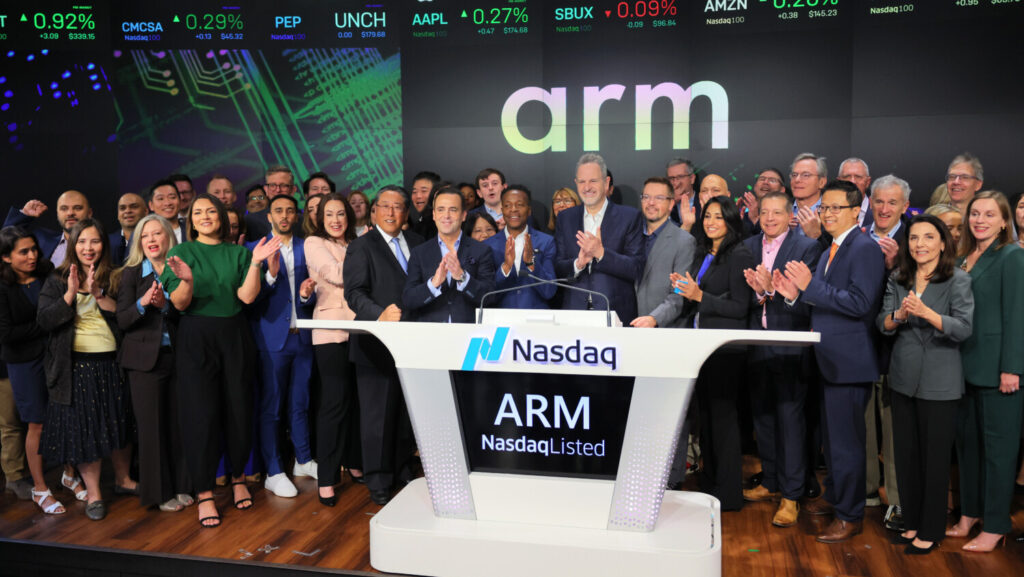Boardroom breaks down British software design company and computer chipmaker Arm Holdings’ history and recent successful second IPO.
Before Arm Holdings made its public debut on the stock market (again) on Sept. 14, you might not have heard much about the company and why this second initial public offering was a big deal.
The British software design firm and computer chipmaker opened on the Nasdaq under the $ARM ticker symbol at a $54.5 billion valuation, which Forbes noted as the largest IPO in nearly two years. Arm’s valuation boosted to $65 billion around opening day, and the company’s stock is trading for about $51 as of Sept. 20.
In this story, Boardroom details everything you need to know about Arm, why the tech company’s public debut made history, and where the business is headed in the chipmaking space.
Arm’s Inception and Growth
Arm launched in Cambridge, England in 1983, but the company was officially incorporated in November 1990 as Advanced RISC Machines, a joint venture among Acorn Computers, Apple, and VLSI Technology. At that time, Larry Tesler, the late Apple executive and computer scientist who also held roles at Amazon, Yahoo, and Xerox, was Arm’s first CEO. The original name didn’t last for long; leadership opted to shorten the moniker to Arm Holdings in 1998 when it first went public.
Apple seeded the initial business with a $3 million investment and the company went on to build RISC processors, a computer architecture for devices that perform specific sets of repeatable activities. RISC processors are often used in small computers, smartphones, tablets, and printers. Arm had its first profitable year in 1993 after successfully developing RISC processors and central processing units (CPUs), the main processors responsible for running operating systems and apps.
Arm says that roughly 250 billion of its microprocessing chips have been used to specifically power smartphones, including Apple’s iPhone. The main draw of Arm’s processors is that they have low electric power consumption, which makes them a good fit for portable devices like phones, digital cameras, and tablets.
The company remained public until 2016 when Japan-based SoftBank acquired it and took it private in a deal valued at $32 billion in cash. The Internet services provider bought Arm to break into the Internet of Things industry, and SoftBank remains a 90% shareholder in Arm following the company’s IPO, giving it voting control over the company’s trajectory.
While SoftBank is primed to net billions from Arm’s IPO, it actually almost sold the company three years ago. In September 2020, Nvidia announced plans to acquire Arm from Softbank in a deal valued at an estimated $40 billion. Nvidia and Softbank faced regulatory scrutiny due to global antitrust concerns, however, with Big Tech companies like Google and Microsoft, also raised concerns about the deal. The merger fell through in February of 2022.
If the transaction had been consummated, it would have been the largest acquisition to date in the semiconductor industry; Softbank would have ended up with a 10% stake in Nvidia.
Arm opened its first American headquarters in Silicon Valley in 1994, along with a Tokyo office. The company moved offices several times on the West Coast before settling into a San Jose-based HQ in 2009. Arm’s workforce is up to about 6,000 global employees, and around 400 of them work out of the San Jose office.
What’s Next for Arm Holdings
As part of its public offering, Arm secured a partnership with Apple that will run “through 2040 and beyond” to license its chip technology to Tim Cook and Co. for the foreseeable future. Today, some of the chipmaker’s other major clients include Alphabet, Intel, Samsung, TSMC, Advanced Micro Devices, and, yes, Nvidia.
Looking ahead, Arm will continue to build processors and license its intellectual property to more tech companies. While Nvidia didn’t get the chance to fold Arm into its business as such, the two companies are worthy competitors in the chip manufacturing market despite their ongoing relationship in other sectors of the tech industry. Nvidia is already a bit ahead, creating chip technology strong enough to power artificial intelligence-enabled supercomputers, but Arm has notably dabbled in that space with room to grow.
How Arm meets the demand for processing units to power supercomputers amid the ever-raging race for AI development will be an intriguing plot to witness as it unfolds.
